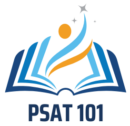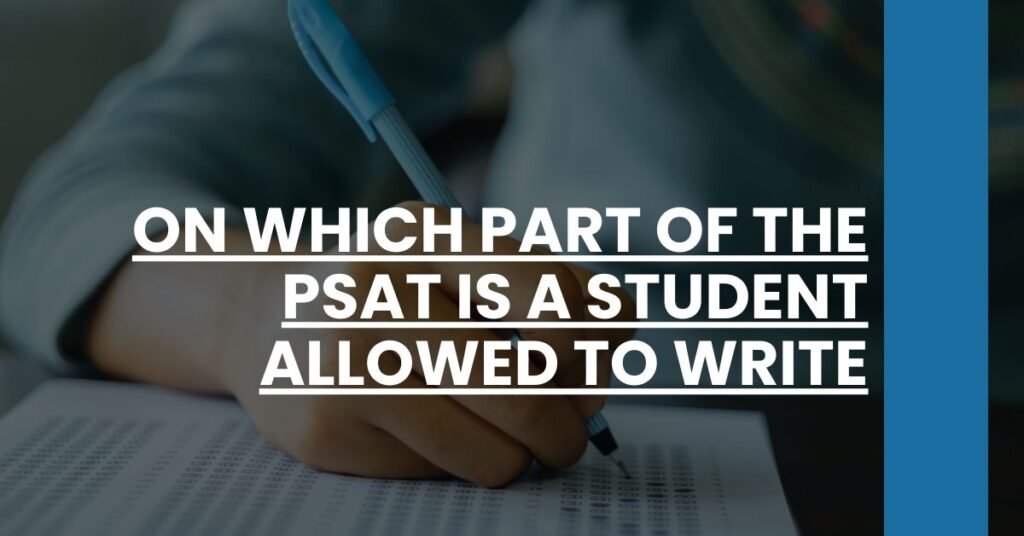Wondering on which part of the PSAT is a student allowed to write? Let’s clarify.
- PSAT Test Booklet: Understand the rules for writing in the test booklet and how it’s used during the exam.
- Math Section Tools: Get insights on utilizing scratch paper effectively in the math segments.
- Answer Sheet Protocol: Learn about the strict guidelines for filling out your answers.
Knowing where writing is permitted can streamline your PSAT experience.
- The PSAT/NMSQT Overview
- PSAT Writing Rules: General Guidelines
- Use of Scratch Paper on the PSAT
- Prohibited Writing During the PSAT
- Test Day: Expectations and Prohibitions
- Accommodations for Students with Disabilities
- Preparing for the PSAT: Tips and Best Practices
- Conclusion: Maximizing Your PSAT Performance
The PSAT/NMSQT Overview
The Preliminary SAT/National Merit Scholarship Qualifying Test (PSAT/NMSQT) is a standardized test that serves as a dual purpose in your academic journey: as practice for the SAT and a stepping stone toward potential scholarship opportunities. Roughly mirroring the SAT in format, the exam is divided into evidenced-based sections that test your critical reading, math, and writing and language skills.
What’s the Purpose?
The PSAT/NMSQT assesses your readiness for college and provides a benchmark for SAT preparation. It also identifies candidates for the National Merit Scholarship Program, offering recognition and financial support to high-scoring students.
What it Consists of
This nearly 3-hour assessment includes the following segments:
- Reading Test: This section focuses on your ability to comprehend and analyze literary and informational texts.
- Writing and Language Test: Here, grammar, punctuation, and understanding of the conventions of Standard Written English are evaluated through a series of passages and multiple-choice questions.
- Math Test: Divided into two parts—with and without a calculator—this section puts your mathematical problem-solving abilities to the test.
Exam Format
Both the reading and writing sections heavily emphasize critical thinking and comprehension skills. While your knowledge is put on display through multiple-choice questions, there is no longer an essay component on the PSAT/NMSQT.
The test’s layout is structured to not only gauge your aptitude but to give you a realistic preview of the SAT. Now that you have a clearer picture of the test structure, let’s delve deeper into where you’re allowed to jot down notes or solve problems on the PSAT.
PSAT Writing Rules: General Guidelines
The PSAT is not just about filling in bubbles; it’s also about strategizing and problem-solving on the spot. While there are rules about where you can write or make marks, understanding these guidelines can give you ease on test day and help you use the test booklet to your advantage.
Marking the Test Booklet
- Test Booklet: You are permitted to write in the test booklet. This means you can underline, circle questions, or jot down notes alongside passages. This freedom can help you stay organized and track your thought process.
- Answer Sheet: On the other hand, you must keep the answer sheet pristine, except for the bubbles you fill in to record your answers. Stray marks or notes can confuse the scanning machines, potentially affecting your score.
Following the Rules
As a rule of thumb, any instructions provided in the test booklet or by the test administrator are there for a reason: to ensure your answers are recorded accurately. While the test might not be the right platform to showcase your artistic doodles, using the space provided to structure your work is not only allowed but encouraged within reason.
Writing Strategically
Using the margins and spaces between questions, you can break down complex problems or brainstorm ideas, ultimately aiding in understanding questions better. Organizing your thoughts in the booklet can translate to clarity in choosing the correct answers.
Use of Scratch Paper on the PSAT
Even the most methodical note-taker will encounter questions or problems that simply need a little more space to dissect. This is particularly true in the math sections, where equations and graphs come into play.
- During the Math Sections: The PSAT’s math portions are where your use of space for writing can really shine. The College Board permits—and even provides—scratch paper alongside your test booklet. You’re free to draft calculations, draw shapes, and map out algebraic expressions.
- Use Your Space Wisely: However, remember to transfer your final answer to the answer sheet meticulously. What you scribble on scratch paper won’t be graded.
A Good Strategy Equals a Good Score
Leveraging scratch paper effectively can keep your work organized and improve your overall efficiency during the test. Practice using scratch paper as part of your PSAT prep to ensure you’re comfortable with this routine by the time test day rolls around.
In essence, the PSAT provides you with opportunities to write and solve problems within the bounds of the test booklet and on designated scratch paper. These tools are there to help you navigate the test more efficiently, giving you the space to think critically and perform your best.
Prohibited Writing During the PSAT
Understanding where and what you cannot write on during the PSAT/NMSQT is crucial to maintaining the integrity of your test results. The College Board has stringent rules to ensure that the exam’s scoring is fair and accurate. Let’s breakdown what is strictly off-limits during the test.
Stray Marks and Annotations
- No Extraneous Marks: Ensure that your answer sheet is free of any marks other than the bubbles you fill in for your answers. Stray marks could cause issues with the scanning process, potentially resulting in a misgraded exam.
- Avoid Writing Personal Information: Only write your personal information in the designated areas on the test booklet and answer sheet. These sections are clearly marked, typically at the beginning of the test materials.
No Tampering or Sharing
- Individual Work Only: Remember, the PSAT is a solo mission. Writing that suggests collaboration or copying is strictly prohibited and will be treated as a rule violation.
Maintaining clarity on your answer sheet ensures a smooth scoring process, while following these rules helps uphold the standardized nature of the PSAT/NMSQT. Adhere to these guidelines to ensure that your hard work is reflected accurately in your score.
Test Day: Expectations and Prohibitions
When you walk into the testing room, it’s important to understand the PSAT’s procedures and what is expected of you. Adhering to the College Board’s rules can help make your PSAT experience as stress-free as possible.
What You Should Do
- Follow Instructions Carefully: Pay attention to the proctor’s instructions and the directions for each section in your test booklet.
- Work Within the Allowed Areas: Use the test booklet and scratch paper provided for any rough work, calculations, and note-taking.
What You Should Not Do
- Don’t Bring Prohibited Items: Items such as calculators with computer algebra systems, smartphones, or smartwatches are not permitted during the PSAT.
- Avoid Unapproved Writing Instruments: Only No. 2 pencils and erasers are allowed for answering and erasing. Pens and highlighters are a no-go.
Your cooperation with these expectations and prohibitions helps maintain a standardized testing environment and ensures that your test results accurately reflect your abilities.
Accommodations for Students with Disabilities
The College Board champions accessibility, ensuring that all students can take the PSAT/NMSQT under conditions that meet their individual needs. If you or someone you know requires accommodations, the process is both considerate and inclusive.
How to Request Accommodations
- Plan Ahead: Seek accommodation approval through the College Board’s Services for Students with Disabilities (SSD) well before test day.
- Documentation Is Key: Provide documentation that confirms your disability and the necessity for specific accommodations.
Types of Accommodations
- Extended Time: You may be granted additional time to complete the test sections.
- Large Print Booklets: These and other assistive tools are available if you need them.
- Permission for Assistive Technology: In some cases, you might be able to use technology like screen readers or Braille devices.
The Writing Accommodations
The accommodations granted may impact on which part of the PSAT you are allowed to engage in different, perhaps more extensive, forms of writing. Always confirm with the College Board ahead of time to understand your approved accommodations.
Preparing for the PSAT: Tips and Best Practices
Preparing for the PSAT/NMSQT goes beyond perfecting your grammar and algebra skills. It also involves knowing how to navigate the rules of the test, especially concerning where and what you can write.
Enhancing Your Writing Skills
- Practice Under Real Conditions: Take full-length practice tests that replicate the test day experience, writing in the test booklet as you would during the actual test.
- Understand the Writing and Language Test: Familiarize yourself with the types of questions you’ll face, paying particular attention to grammar, usage, and punctuation.
Practical Note-Taking Strategies
- Keyword Notation: Develop a system of symbols or abbreviations that can help you quickly note essential points or questions.
- Problem-Solving Layouts: For math problems, practice setting out your working in a clear and organized manner on scratch paper.
By incorporating these strategies and tips into your PSAT preparations, you’ll become more adept at managing your time and utilizing the writing allowances to your advantage.
Conclusion: Maximizing Your PSAT Performance
Recognizing on which part of the PSAT you are allowed to write is a small but significant piece of the puzzle in achieving a top score. By combining knowledge of these rules with methodical preparation, you can approach your PSAT with confidence.
Adequate preparation includes understanding the College Board’s guidelines, honing your writing skills for clear note-taking, and, if applicable, arranging necessary accommodations. These steps will ensure you’re well-equipped to showcase your academic capabilities fully and accurately during the PSAT/NMSQT.

